The community at Nation1099 gives the question of how to estimate and set freelance rates a lot of thought. We have several articles on the subject linked at the bottom of this post. In this article, we’re really going to dig in. Along the way I’ll:
- explain in a lot of detail a method for calculating your rate.
- show you the formula I’m using so you can use it to establish yours.
- demonstrate that formula using the example of an experienced freelance web developer.
- give you an interactive calculator so you can try out the formula yourself.
Updated: After getting more input from freelance career coaches, I’ve now think that it’s more accurate to say this formula helps you figure your all-in expenses, which then should inform how you set freelance rates. This is less about setting your rate than knowing the minimum you ought to charge.
And I want to underscore minimum freelance rates, because as we’ll see at the end, this formula produces a result somewhat lower than other rules of thumb.
Another limitation of the formula is that it is formulaic rather than strategic. For example, you really should be setting rates according to the value to the client of the service you provide. If you are responsible for bringing in $1m in revenue for the client, you would be silly to charge them only what the formula shows.
Put another way, what this formula gives you is many of the “replacement costs” of running your own freelance business rather than doing similar work on somebody’s payroll. It shows the costs you have taken on for yourself from your old employer in going freelance and therefore costs that should be built into your rates.
What you need to remember is that the all-in expenses of a payroll position is greater than just the salary. Your old employer spent a lot more on employing you than just that salary number.
So when you go from salaried to freelance, you need to cover those costs other than salary. The actual revenue you need to replace is higher than most freelancers account for. With a clear picture of those total replacement costs, you can make better decisions about setting your freelance or consulting rate.
So, as old-fashioned as charging hourly fees for freelance work may be, knowing an hourly rate gives you a common unit of measure to calculate with.
A few caveats before we dive in:
- First, all of this assumes you are in an area with average living expenses.
- Second, I didn’t factor in how your experience or skill level might be different. You can capture that variation in the salary you input in the first line of the calculator. The example I’m using assumes 10 years of experience at least for the web developer.
- Third, this doesn’t account for the fact that some freelancers will make lifestyle choices that affect how they set freelance rates. Some freelancers are comfortable earning less because they like the freedom. They are essentially giving money back to clients so they can have flexibility that isn’t possible otherwise. This formula at least clarifies how much that freelancer is giving back.
- Fourth, the inputs used below are United States-centric. Professionals in countries with different pension, healthcare and vacation policies may not find all these number close to their experience. However, the calculator will let you adjust for those differences.
- The last caveat is that all of this assume a straightforward solo business in the digital world with no subcontractors, no employees and no materials. Those would alter the result in ways that are harder to apply generally for most freelancers.
Throughout this article, I’m going to use the example of a web developer. You can run the numbers for another profession by searching for the salary data from places like Glassdoor.
The Glassdoor data on web developer salaries is $88,488 for the national average as I write this.
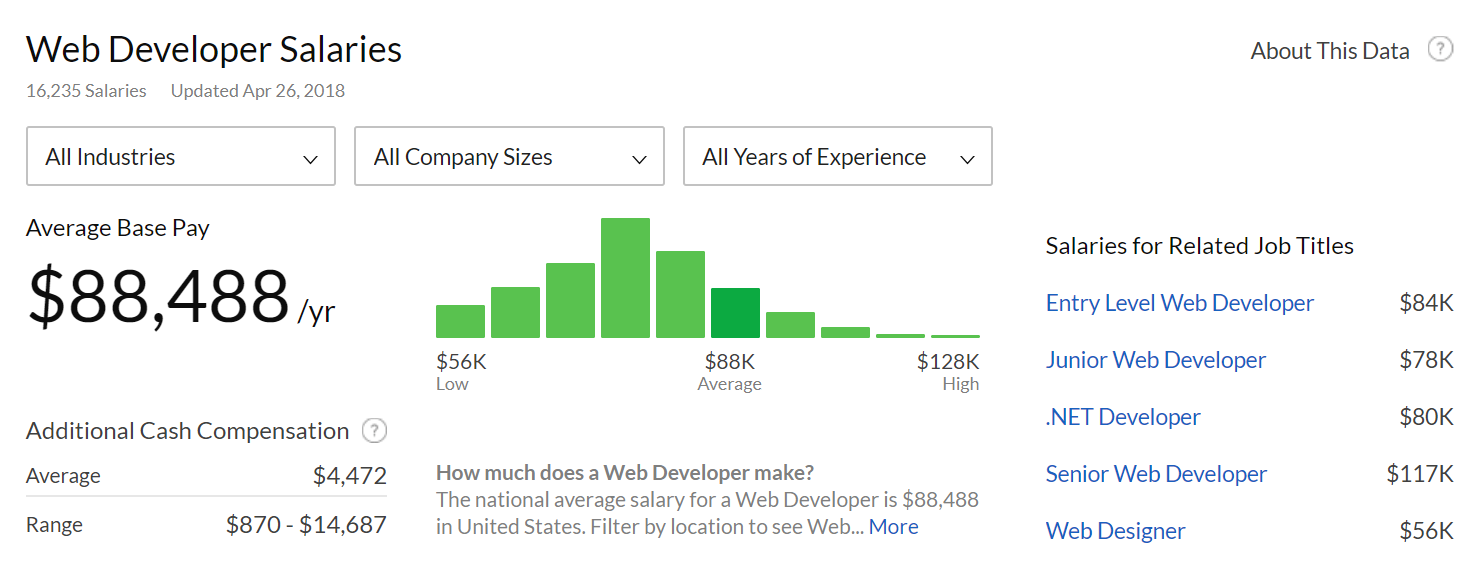
Let’s round it up to $90,000 to simplify our calculations.
OK, let’s figure out the rate this web dev should charge when they quit their job and go freelance.
1. Start with the annual salary equivalent (but don’t stop there)
First, a do not. To set freelance rates, do not simply take the salary earned by professionals in your field and divide that to get an hourly rate as a freelancer. You will be starving or out of business pretty soon.
Just so we’re working with a round 50 week number, let’s assume two weeks of vacation, which is too low for most professional roles. So our inputs are already going to give our future clients a break.
The rookie mistake here is to to set freelance rates by taking the $90k, dividing by 50 weeks, dividing again by 40 hours/week and settling on an hourly rate of $45.
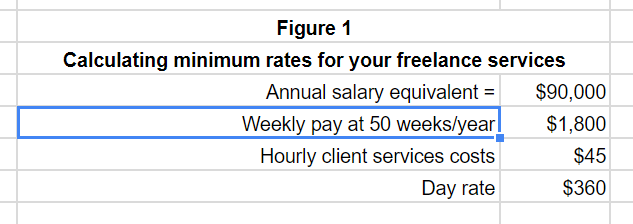
Do not charge your freelance clients $45/hour for web developer services.
That $45/hour only establishes the direct client services part of your freelance business. It’s the cost of the time you are putting in working for the client.
That’s like saying your former employer’s only expense was salaries and nothing else. They had a lot of other expenses, and so do you now that you’re the owner of your freelance business.
You might be thinking that $45/hour sounds like a lot. After all, it’s about four times minimum wage, depending on where you live. And, as we’ve just demonstrated, it can in theory add up to as much as a salaried role for this work.
The first problem with this is that it assumes you will be fully booked. But nobody ever is.
Suppose this web developer is booked 80 percent of the time. For example, they work hard for their clients for two months or eight weeks, and then they hit a dry spell. They spend two weeks hustling for other clients (a.k.a. marketing and sales) but not doing billable client work.
In that case, if they are charging $45/hour, they have essentially taken a 20 percent cut in pay to go freelance.
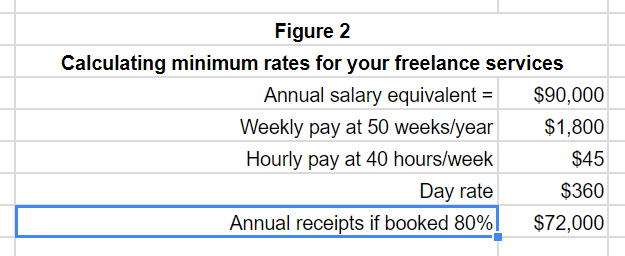
Or, put another way, this web dev is giving back 20 percent of their income to clients when they switched from a W-2 role to a 1099 role.
The salary equivalent just tells you the owner’s salary portion of your freelance rate.Let’s assume a perfect world where the freelancer 100 percent fully booked all the time. There is still a big flaw to stopping at just the salary equivalent. Salary is a different concept from rates and fees for an independent contractor. Salaries alone don’t account for all the costs you need to pay attention to.
All the simple division of the salary equivalent by hours has told us so far is the client services expense of your freelance business. The client services expense is the hourly rate of what an employer pays in the form of salary if they had a web dev on the payroll.
But that that is not the total cost to you. Nor is it the value of the service to the client.
That salary equivalent is a useful number to start with. But it’s only a start.
For reasons we’ll see below, it helps if we label this item as the “owner’s salary.”

Salary is only a fraction of the employer’s expense. Therefore, when you set freelance rates, the owner’s salary is only a fraction of your expense.
Some of those expenses are actual cash costs.
And some of those expenses are unpaid labor without a cash outlay.
Let’s start counting them up and seeing how the get built into your freelance rates.
2. Add in the cash costs of being self employed
Again, we’re calculating the cost of going freelance — the expenses that your former employer had and that you now need to cover yourself.
Some of the actual cash expenses that inform your freelance rate include:
The employer share of an employee’s retirement plan
If you are self-employed, you need to account for both the employee contributions you were making into your 401k plan (in the U.S. system) and the employer contributions to your retirement plan.
(The SEP-IRA is a great way to reproduce both sides of that retirement savings.)
The employer’s contribution to health insurance expenses
Maybe you don’t need to spend money on health insurance because you have it covered through a spouse, but you should still include that cost in your calculation to understand the replacement cost of being a freelancer rather than a W-2 employee.
The employer’s expense of marketing and selling its product
It may seem counter intuitive to charge one client for the expense of finding other clients. But if you think about it, every business charges their customers a price that covers all their expenses. That includes the cost of finding more customers.
For example, the price you pay for coffee at Starbucks includes the cost of their marketing. It doesn’t matter if you personally don’t like pumpkin spice in your latte. The cost of all those ads every fall is built into the price of the products you do buy.
Similarly, suppose you need call the plumber. How did they market to get your attention? They put out those yard signs. They paint their name on the side of their work van. They hired an SEO specialist to get their name to the top of Google’s local search results. It doesn’t matter if you found the plumber some other way. The fee you pay is going to include that plumber’s expenses for marketing.
The employer’s costs for all other overhead like software, communications equipment and paying the light bill
The same idea. Starbucks spreads those costs out over all those cups of coffee. As a customer, you aren’t paying just for the beans, the hot water and the time of the barista. You are paying a tiny share of all the money Starbucks spends when you aren’t even there, such as cleaning services and bookkeeping.
Similarly, the price you pay the plumber includes their cost for accounting and insurance. If the plumber expects to pay their accountant $500 next April to do the taxes, a fraction of that that will be built into fee you pay today.
Your overhead expenses need to be spread out over the fees you charge your freelance clients. What are your overhead expenses? Well, you do have a budget for your freelance business, don’t you?
The employer share of payroll taxes
Now that you are self-employed, you have to cover that expense in the form of the self-employment tax.
So far, all of these expenses actually come out of your pocket, and for the most part they are tax deductible. Let’s see what we have so far.
3. Add in the cost of unpaid activities in your freelance business
Going forward it will help to think of yourself as two different personas. You are the labor in your business, and you are the owner working on your business. The first persona does all the work serving the clients. The second persona does all the other work necessary to make the business run.
When you set freelance rates: the owner side of your persona needs to pay the labor side. That’s the owner’s salary in the first row of the formula.
But the owner needs to pay himself or herself for all that other work that isn’t client facing.
And you need to account for other unpaid activities.
Again, it helps to identify all the costs an employer would bear for a salaried role that have shifted to you as the owner of your freelance business. Your rate needs include all the expenses you incur running your business, whether it’s a cash expense or the cost of your time for these other activities. Let’s count them off.
The employer’s expense for paid time off
This includes paid holidays, vacation days, sick days and personal days.
It might seem counter intuitive to charge a client for your time off, but you should think of this as the cost of flexibility. The client wants fluid and temporary labor costs rather than fixed costs, and this is how they pay for it.
If you were an employee, would you expect paid time off for holidays, sick days, vacation days and personal days?
Then the business owner side of you needs to pay the labor side of you for days off. The only way that happens is if you account for it when you set freelance rates. Otherwise, your only vacation days will be unpaid vacation days. Which is just another way of giving away value to your clients.
The employer’s business development activities
This has the same rationale as the marketing expenses covered above, but up there we were talking about actual cash outlays such as printing, support services or advertising. We also need to account for the time you are putting in.
This is where that time that you are not fully booked that we discussed earlier gets accounted for. So, for example, the web dev with a two-week dry spell is presumably putting that time into marketing and sales — business development. (Ideally, they are more strategic about scheduling their biz dev activities than that. Check out our article on getting freelance clients for more on that subject.)
Put another way, not all the work on your business is client facing, but all of the work on your business must be built into the prices you charge clients.
If your clients don’t pay for the work you do on your business, who does?
You do. And if you’re going to let that happen, you might as well be back on somebody’s payroll and collecting a salary.
There is one last critical piece to setting your freelance rates:
The employer’s profit
To understand how this rolls into your freelance rate, think about one of your clients, and then think about what they charge their own customers. The price your client charges its customers accounts for all the expenses we’ve discussed above, but it doesn’t stop there.
They charge a price that covers all of that plus a profit. After all the employees and vendors get paid, the shareholders get paid.
And in your freelance business, you are the shareholder. You paid the labor persona for your client-facing work. But when does the owner side of you get paid for the risk you are taking and for all the sweat equity you are putting in?
Right here at the line labeled “owner’s profit.” This is the return on investment — return to you of the investment you are making to establish a freelance business. I discuss these concepts at more length in this article on owner’s profit vs. owner’s salary.
Why should your clients pay for this? Because by hiring a freelancer instead of putting someone on their payroll, they are increasing their own profitability (or accelerating their growth if they are in a startup stage) by offloading risk and fixed costs to you. Set your freelance rates to capture some of that profitability for yourself.
Alright, those are all the variables going into the formula. Let’s see it so far.
4. Plug estimates into the formula to set freelance rates
That’s the theory. Now you’re ready to find some estimates and plug them into the formula to calculate your freelance fee.
There are a wide variety of estimates out there for each of these variables, so the exact inputs are going to be debatable. In fact, if you have experience or a different point of view on the amount for any of these variables, please let me hear it in the comments. The inputs reflect my best effort to research averages for each item.
We’ve also built a calculator so you can play with these variables yourself to come up with your own freelance rate. That’s linked from the bottom of the article.
Retirement expenses
I’m a big proponent of aggressively using tax advantaged retirement plans like a 401k. If the web dev’s employer had a 5/10 contribution plan and they participated fully, then that’s 15 percent. (A SEP-IRA will actually let you contribute more.)
Remember, this is separate from a personal IRA. You would have paid for that out of your salary as an employee. This is about replacing the employer sponsored retirement plan.
Health insurance expenses
This is the hardest item to get estimates on (for U.S. freelancers). The numbers are all over the place depending on where you live, when the research was done, whether you need single coverage or family coverage and which way the political winds are blowing. I’m going to use a flat $10,000 annual health insurance premium.
Marketing expenses
Many small business budgets encourage you to spend 8 to 10 percent of your budget on marketing, exclusive of sales activities. That might be buying Facebook ads or paying a subcontractor to help you create an ebook that you give to prospective clients.
Are you thinking you can skimp here and rely on word-of-mouth to make your freelance business grow? Check out what our friend Ilise Benun, the Marketing Mentor, says about that counterproductive attitude.
(By the way, Ilise has 20+ years of experience giving business and marketing advice to freelancers. You should definitely check out the resources she offers.)
Nevertheless, freelancers tend to be DIYs when it comes to marketing, so I’ll use the low-end of the range — 8 percent.
Overhead expenses
Overhead, depending on the kind of freelance business you are running, might be another 20 percent. That’s lights, internet, rent, supplies, furniture, etc. All that stuff that your accountant is reminding you to deduct on your freelance taxes.
Self-employment taxes
How much are self-employment taxes? It partly depends on what state you live in. Let’s put in 18%.
Here’s where we are so far on the cash costs of being self employed:
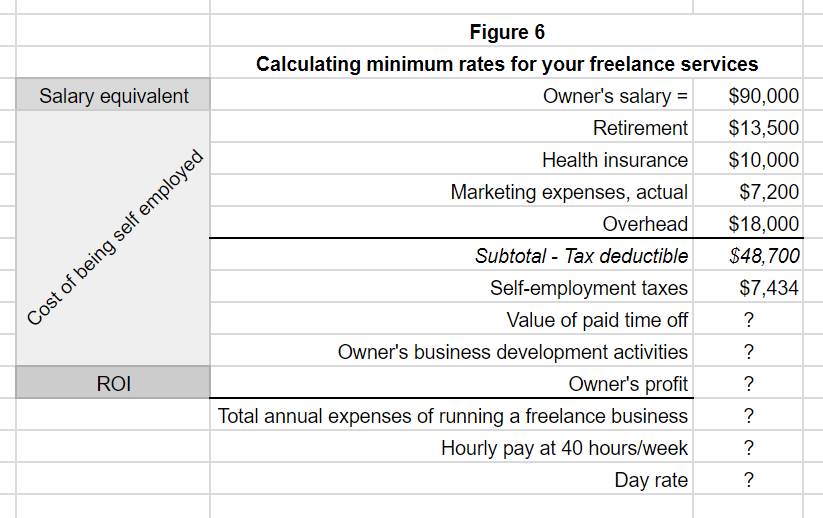
Value of paid time off
Paid time off for experienced salaried professionals adds up to about 40 days/year. That’s 10 holidays, 20 vacation days (4 weeks) and 10 sick days and personal days. That’s equal to 15.38 percent of a full working schedule, which I’ll round down to 15 percent in this table. (The calculator linked below is a little more precise at .384 percent per day off.)
Value of business development activities
As we said above, if you think you’ll be booked 80 percent of the time, then you’ll presumably be putting 20 percent of your time toward marketing and sales activities. You need to pay yourself for that just like you pay yourself for vacation days.
You actually should aim to be less than fully booked. That doesn’t mean you have to find more clients. It means you get to find better clients. If you don’t have time to work on business development because you’re too busy, then your current clients aren’t paying you enough. Raise your rates until enough of them bow out that you have time for biz dev.
Value of owner’s profit
Estimating owner profit is partly a guess and partly a fantasy about the grand success your freelance business will be. But it’s important to have a goal. Let’s call it 20 percent.
Another way of thinking of this is that the web dev is going to pay their labor persona side $45/hour for client work during the year and then, if everything goes well, pay their owner persona side a year-end bonus of 20 percent of the original salary equivalent.
How you decide to divide up that 20 percent profit is another question. I always encourage freelancers to set aside 10 percent as a reserve to invest back into their business. Then the rest goes to yourself as the shareholder.
Or, to think of it another way, you are planning to end the year in the black by 20 percent. Half of that will go to yourself in the form of a dividend to you as the shareholder of your business, and half you plan to set aside to use next year.
The reserve might be a just-in-case-business-declines fund so in the future you can better handle ups and downs in your income. Or it might be funds you are saving up to reinvest in to your business. For example, if you are thinking of developing products to sell, a reserve fund saved from last year’s profits can help you do that.
But for now let’s keep all the profit bundled together in a single owner’s profit line.
Calculate the grand total – What should the freelance web dev charge under this formula?
This formula with the estimates I used result in a minimum hourly rate of $94 or a day rate of $752 for our freelance web dev.
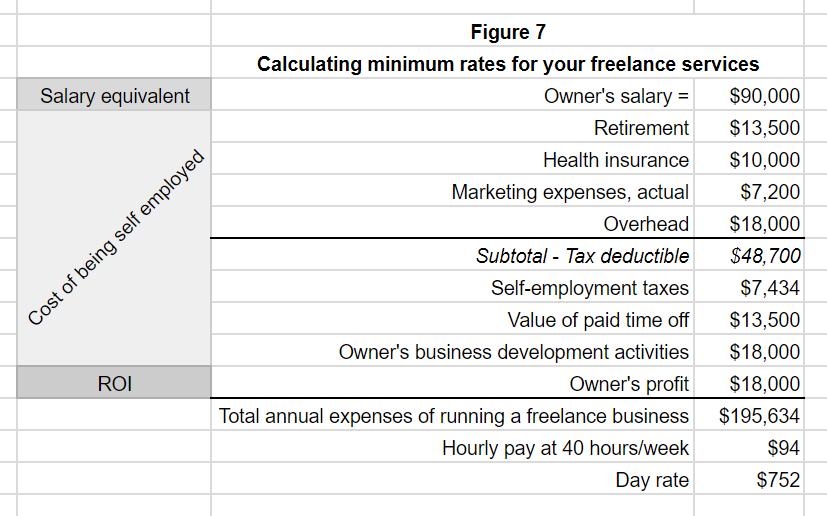
This tells you most of the all-in cost to you of being a freelancer for your client instead of being on their payroll. You should use this as a guideline to set your rates, whether you price by the project, sell retainers or price by the value that clients get from the project.
As Ilise Benun reminds us in the comments below, this hourly rate is not something you necessarily share with your clients. It’s a reference point you use when discussing your fee in a more strategic way.
Now, if you look closely at the calculation and you’ve been reading about how to set freelance rates elsewhere, you might notice something interesting. We’ve taken the long way around to arrive at a recommendation similar to two simple rules of thumb shared by others before.
The first common rule of thumb for setting freelance rates is that the hourly fee for consultants and freelancers should be between 2 and 2.5 times the hourly equivalent of that work in a salaried role. This result of this formula is slightly more than two times the hourly equivalent.
The second rule of thumb for setting freelance rates comes from Marion McGovern’s book Thriving In the Gig Economy. She recommends what she calls the “one percent rule.” Her rule states your daily fee should be one percent of the equivalent annual salary. This formula came up somewhat short of that with a day rate equal to .83 percent of the original salary.
The difference? I can think of three other reasonable costs I left out that would push the result closer to the one percent rule or to 2.5 times salary:
- First, you probably have additional expenses other than the overhead I described, including travel, meals, courses and other training, conferences, association fees, certifications, etc. (In the calculator, you can increase the overhead line to reflect your own actual expenses.)
- Second, some would argue that freelancers should also charge their clients the equivalent of “cost to hire” that an employer would bear for a traditional employee — all the expenses associated with finding, onboarding and training employees. That includes the expense of recruiters and H.R. departments. I’m not building that in here, but if I did, that would get the result closer to the one percent rule.
- Third, this doesn’t capture the time you put in for management of your business other than what’s included in business development. (I added a row for that into the calculator, though.)
Are you setting your freelance rates at least as high as this formula calculates?
Hopefully yes, because this shows a reasonable estimate of the actual cost of running your freelance business like a business.
And remember, as I’ve argued before, if you’re not running it like a business, you’re running it like a day laborer or a hobbyist. You’re giving value back to your clients in the mistaken belief that you should accept being paid less for having the work-life balance that you want.
That’s not necessary. Set freelance rates to reflect the fact that you are running a business and that your work is t least as valuable as the work of the full-time employee they’ve chosen not to hire. Probably more so, since the data shows that freelancers are on average better educated, more engaged and more actively maintaining their skills.
Additional reading to help you set freelance rates
Getting the Freelance Rate You Deserve
How to Smartly Raise Your Rate (and Handle Unsustainable Clients)
5 Biggest Things You’re Forgetting in Your Freelance Rates
7 Powerful Strategies for Getting Recurring Income as a Freelancer
The Path To Higher Paying Clients – Insights From the Marketing Mentor
The Beginner’s Guide To Getting Upfront Payment From Freelance Clients
2 Signs Your Freelance Fees Are Too Low
Is A Client Putting You In A Crunch — Charge a Rush Fee!

Robert McGuire
Publisher of Nation1099
Robert McGuire is the owner of McGuire Editorial, a content marketing services firm specializing in B2B and tech startups.


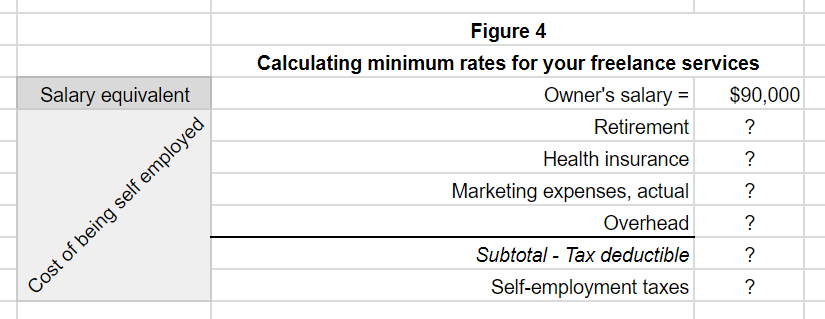
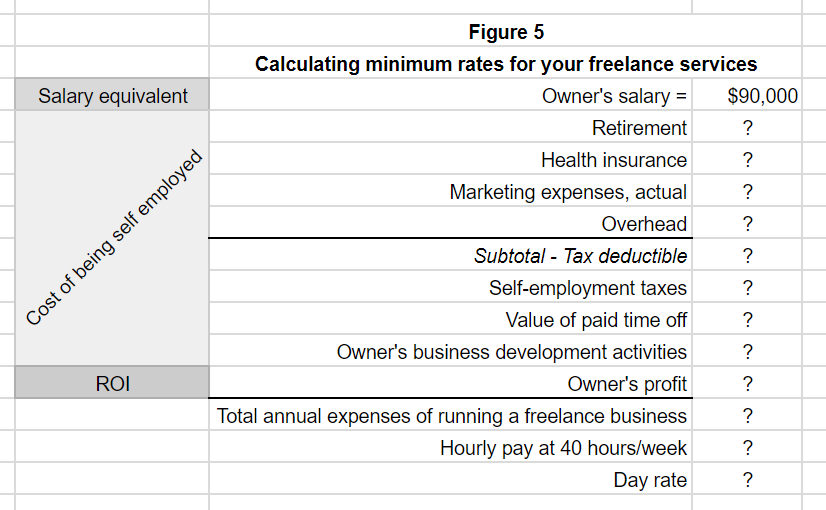









Great and comprehensive post on how to come up with an hourly rate — bravo! However, now that you know your hourly rate, keep it to yourself. It’s really no one’s business, especially if you practice one of the many pricing strategies available to freelancers, including fixed fees, package or tiered pricing, retainer or value-based pricing and more. (I cover all of this in my CreativeLive course, Command the Fees You Deserve.) That said, there are exceptions to this rule and I’ve just written a blog post on them here: https://www.marketing-mentor.com/blogs/news/charging-hourly-should-you-or-shouldnt-you
Ah, yes. Excellent point Ilise. I should be clearer that this formula is about knowing for yourself an hourly rate. It might even be clearer to say this is simply a calculation of what your expenses are so that you can charge enough to cover those expenses. From there, how you charge and how you communicate that to prospective clients are different issues that folks like yourself are providing some excellent coaching on.